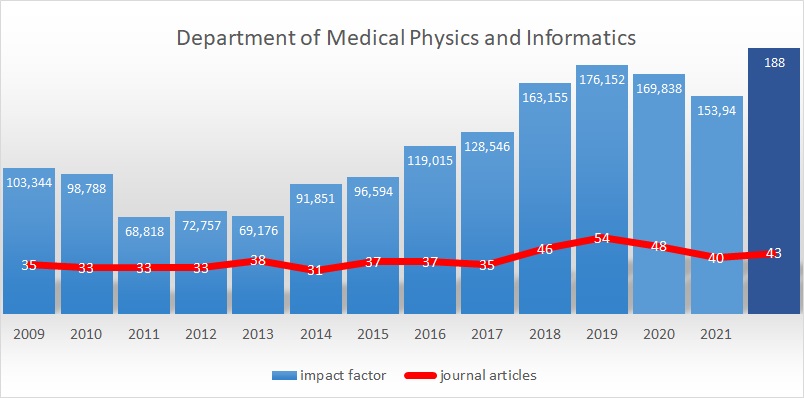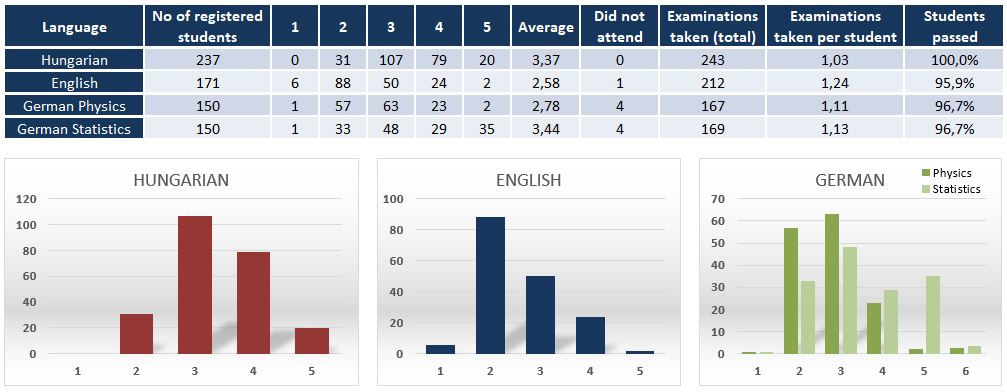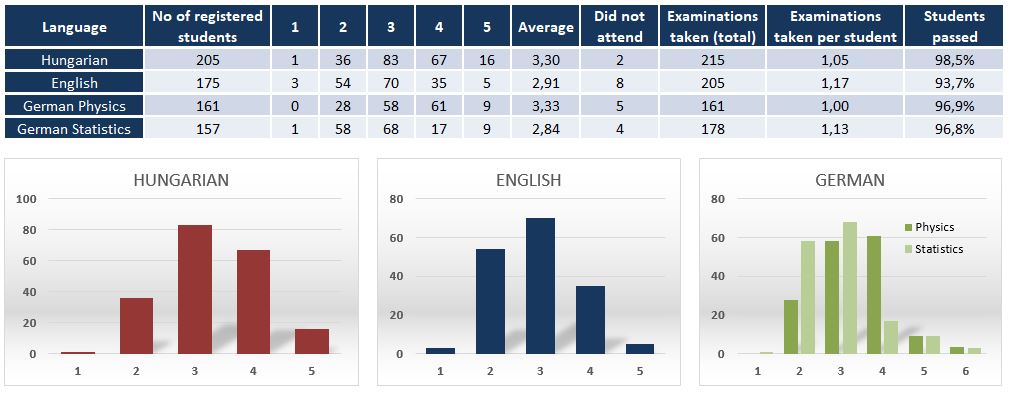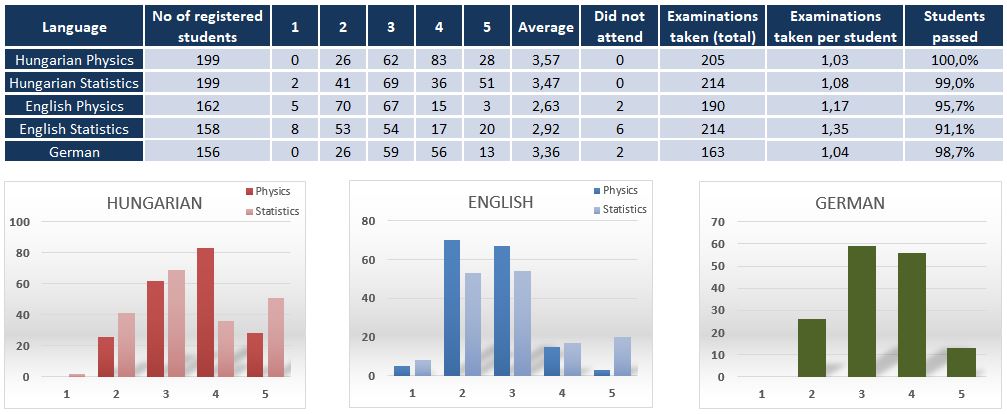Publications in 2022

43 journal articles, one book chapter, impact factor: 188
| Papers | IF | |
| 1. | Abdelghafour MM, Orbán Á, Deák Á, Lamch Ł, Frank É, Nagy R, Ziegenheim S, Sipos P, Farkas E, Bari F, Janovák L. Biocompatible poly(ethylene succinate) polyester with molecular weight dependent drug release properties. Int J Pharm. 2022 Apr 25;618:121653. | 3,061 |
| 2. | Gargyan I, Dozsai D, Csonka I, Rarosi F, Bodzay T, Csonka A. Bisphosphonate therapy associated with bilateral atypical femoral fracture and delayed union. Joint Dis Relat Surg. 2022;33(1):24–32. | 1,549 |
| 3. | Kis M, Smart JL, Maróti P. Capacity and kinetics of light-induced cytochrome oxidation in intact cells of photosynthetic bacteria. Sci Rep. 2022;12(1):14298. | 4,997 |
| 4. | Etlinger P, Barroso C, Miranda A, Moreira Pinto J, Lamas-Pinheiro R, Ferreira H, Leão P, Kovács T, Juhász L, Sasi Szabó L, Farkas A, Vajda P, Kálmán A, Géczi T, Simonka Z, Cserni T, Nógrády M, Fodor GH, Szabó A, Correia-Pinto J. Characterization of technical skill progress in a standardized rabbit model for training in laparoscopic duodenal atresia repair. Surg Endosc. 2022 Apr;36(4):2456–65. | 3,453 |
| 5. | Paszt A, Ottlakan A, Abraham S, Simonka Z, Vas M, Maraz A, Szepes Z, Tiszlavicz L, Nyari T, Olah J, Lazar G. Clinical benefits of oral capecitabine over intravenous 5-fluorouracyl regimen in case of neoadjuvant chemoradiotherapy followed by surgery for locally advanced rectal cancer. Pathol Oncol Res. 2022;28:1610722. | 2,874 |
| 6. | Kondoros BA, Berkesi O, Toth Z, Aigner Z, Ambrus R, Csoka I. Cyclodextrin Complexation of Fenofibrate by Co-Grinding Method and Monitoring the Process Using Complementary Analytical Tools. Pharmaceutics. 2022 Jul;14(7):1329. | 6,525 |
| 7. | Jávor P, Rárosi F, Horváth T, Török L, Varga E, Hartmann P. Detection of exhaled methane levels for monitoring trauma-related haemorrhage following blunt trauma: study protocol for a prospective observational study. BMJ Open. 2022 Jul 6;12(7):e057872. | 3,007 |
| 8. | Lohner T, Nemeth A, Zolnai Z, Kalas B, Romanenko A, Khanh NQ, Szilagyi E, Kotai E, Agocs E, Toth Z, Budai J, Petrik P, Fried M, Barsony I, Gyulai J. Disorder and cavity evolution in single-crystalline Ge during implantation of Sb ions monitored in-situ by spectroscopic ellipsometry. Mater Sci Semicond Process. 2022 0;152:107062. | 4,644 |
| 9. | Peták F, Balogh ÁL, Hankovszky P, Fodor GH, Tolnai J, Südy R, Kovács BN, Molnár A, Babik B. Dopamine Reverses Lung Function Deterioration After Cardiopulmonary Bypass Without Affecting Gas Exchange. J Cardiothorac Vasc Anesth. 2022 Apr;36(4):1047–55. | 2,894 |
| 10. | Institóris L, Hidvégi E, Kovács K, Jámbor Á, Dobos A, Rárosi F, Süvegh G, Varga T, Kereszty ÉM. Drug consumption of suspected drug-influenced drivers in Hungary (2016-2018). Forensic Sci Int. 2022 Jul;336:111325. | 2,676 |
| 11. | Török L, Jávor P, Török K, Rárosi F, Hartmann P. Early Return to Play After Anterior Cruciate Ligament Reconstruction: Is It Worth the Risk? Ann Rehabil Med. 2022 Apr;46(2):97–107. | 0,63 |
| 12. | Dos Santos Rocha A, Diaper J, Balogh AL, Marti C, Grosgurin O, Habre W, Peták F, Südy R. Effect of body position on the redistribution of regional lung aeration during invasive and non-invasive ventilation of COVID-19 patients. Sci Rep. 2022 Jun 30;12(1):11085. | 4,997 |
| 13. | Maroti P, Kis M. Environmental protection via biomonitoring lead exposure by photosynthetic purple bacteria. Plant Physiol Rep [Internet]. [cited 2022 Dec 30]; Available from: https://www.webofscience.com/wos/woscc/summary/fab15c8d-125a-4e2a-9188-a22e02f7a860-67f3c5ef/relevance/1 | 0 |
| 14. | Spekker E, Bohár Z, Fejes-Szabó A, Szűcs M, Vécsei L, Párdutz Á. Estradiol Treatment Enhances Behavioral and Molecular Changes Induced by Repetitive Trigeminal Activation in a Rat Model of Migraine. Biomedicines. 2022;10(12):3175. | 4,757 |
| 15. | Schranc Á, Fodor GH, Südy R, Tolnai J, Babik B, Peták F. Exaggerated Ventilator-Induced Lung Injury in an Animal Model of Type 2 Diabetes Mellitus: A Randomized Experimental Study. Front Physiol. 2022;13:889032. | 4,755 |
| 16. | Peták F, Fodor GH, Schranc Á, Südy R, Balogh ÁL, Babik B, Dos Santos Rocha A, Bayat S, Bizzotto D, Dellacà RL, Habre W. Expiratory high-frequency percussive ventilation: a novel concept for improving gas exchange. Respir Res. 2022 Oct 15;23(1):283. | 7,162 |
| 17. | Schranc Á, Balogh ÁL, Diaper J, Südy R, Peták F, Habre W, Albu G. Flow-controlled ventilation maintains gas exchange and lung aeration in a pediatric model of healthy and injured lungs: A randomized cross-over experimental study. Front Pediatr. 2022;10:1005135. | 3,569 |
| 18. | Kallab R, Sudy R, Dos Santos Rocha A, Diaper J, Petak F, Keli Barcelos G, Habre W. Invasive and non-invasive assessment of macro- and micro-circulatory effects of vasopressors during sevoflurane anesthesia in a pediatric experimental model: A randomized trial. Paediatr Anaesth. 2022 Oct;32(10):1129–37. | 0,983 |
| 19. | Sipka G, Nagy L, Magyar M, Akhtar P, Shen J-R, Holzwarth AR, Lambrev PH, Garab G. Light-induced reversible reorganizations in closed Type II reaction centre complexes: physiological roles and physical mechanisms. Open Biol. 2022;12(12):220297. | 7 |
| 20. | Laurent D, Riek J, Sinclair CDJ, Houston P, Roubenoff R, Papanicolaou DA, Nagy A, Pieper S, Yousry TA, Hanna MG, Thornton JS, Machado PM. Longitudinal Changes in MRI Muscle Morphometry and Composition in People With Inclusion Body Myositis. Neurology. 2022 0;99(9):E865–76. | 12,258 |
| 21. | Schranc Á, Fodor GH, Südy R, Ballók B, Kulcsár R, Tolnai J, Babik B, Peták F. Lung and chest wall mechanical properties in metformin-treated and untreated models of type 2 diabetes. J Appl Physiol (1985). 2022 May 1;132(5):1115–24. | 3,881 |
| 22. | Menyhárt Á, Frank R, Farkas AE, Süle Z, Varga VÉ, Nyúl-Tóth Á, Meiller A, Ivánkovits-Kiss O, Lemale CL, Szabó Í, Tóth R, Zölei-Szénási D, Woitzik J, Marinesco S, Krizbai IA, Bari F, Dreier JP, Farkas E. Malignant astrocyte swelling and impaired glutamate clearance drive the expansion of injurious spreading depolarization foci. J Cereb Blood Flow Metab. 2022 Apr;42(4):584–99. | 6,597 |
| 23. | Császár E, Lénárt N, Cserép C, Környei Z, Fekete R, Pósfai B, Balázsfi D, Hangya B, Schwarcz AD, Szabadits E, Szöllősi D, Szigeti K, Máthé D, West BL, Sviatkó K, Brás AR, Mariani J-C, Kliewer A, Lenkei Z, Hricisák L, Benyó Z, Baranyi M, Sperlágh B, Menyhárt Á, Farkas E, Dénes Á. Microglia modulate blood flow, neurovascular coupling, and hypoperfusion via purinergic actions. J Exp Med. 2022 Mar 7;219(3):e20211071. | 17,579 |
| 24. | Lemale CL, Lückl J, Horst V, Reiffurth C, Major S, Hecht N, Woitzik J, Dreier JP. Migraine Aura, Transient Ischemic Attacks, Stroke, and Dying of the Brain Share the Same Key Pathophysiological Process in Neurons Driven by Gibbs-Donnan Forces, Namely Spreading Depolarization. Front Cell Neurosci. 2022;16:837650. | 6,147 |
| 25. | Sarrai AE, Belaissa Y, Kirdi R, Hanini S, Szabo T, Nagy L. Modeling and optimization of Tylosin adsorption using dehydrated wheat bran: adsorption behaviors, kinetic and thermodynamic studies. React Kinet Mech Catal. 2022 0;135(4):1905–28. | 1,843 |
| 26. | Fabo C, Oszlanyi A, Lantos J, Rarosi F, Horvath T, Barta Z, Nemeth T, Szabo Z. Non-intubated Thoracoscopic Surgery-Tips and Tricks From Anesthesiological Aspects: A Mini Review. Front Surg. 2021;8:818456. | 2,568 |
| 27. | Cserni B, Bori R, Csörgő E, Oláh-Németh O, Pancsa T, Sejben A, Sejben I, Vörös A, Zombori T, Nyári T, Cserni G. ONEST (Observers Needed to Evaluate Subjective Tests) suggests four or more observers for a reliable assessment of the consistency of histological grading of invasive breast carcinoma: A reproducibility study with a retrospective view on previous studies. Pathol Res Pract. 2022;229:153718. | 3,309 |
| 28. | Luckl J, Baker W, Boda K, Emri M, Yodh AG, Greenberg JH. Oxyhemoglobin and Cerebral Blood Flow Transients Detect Infarction in Rat Focal Brain Ischemia. Neuroscience. 2022;509:132–44. | 3,708 |
| 29. | Anna V, Bernadett B, Andrea O, Mónika S, Attila N, ifj LG, István B, Péter K, Tamás V, Csaba L. Peripheral sensory and cardiovascular autonomic dysfunction in kidney transplant patients. DIABETES STOFFWECHSEL UND HERZ. 2022;31(3):42–50. | 0,18 |
| 30. | Dos Santos Rocha A, Peták F, Carvalho T, Habre W, Balogh AL. Physiologically variable ventilation prevents lung function deterioration in a model of pulmonary fibrosis. J Appl Physiol (1985). 2022 Apr 1;132(4):915–24. | 3,881 |
| 31. | Hajdu K, Balderas-Valadez RF, Carlino A, Agarwal V, Nagy L. Porous silicon pillar structures/photosynthetic reaction centre protein hybrid for bioelectronic applications. Photochem Photobiol Sci. 2022;21(1):13–22. | 4,328 |
| 32. | Cserni G, Ambrózay É, Serényi P, Bori R, Sejben I, Csörgő E, Serfőző O, Lóránd K, Venczel L, Maráz R, Sinkó M, Szeleczki N, Nyári T, Zombori T. Preoperative axillary nodal staging of invasive lobular breast cancer with ultrasound guided fine needle aspiration in patients with suspicious ultrasound findings versus aspiration in all patients - A retrospective single institutional analysis. Eur J Surg Oncol. 2022 Apr;48(4):742–7. | 3,184 |
| 33. | Pálinkás ED, Re F, Peteiro J, Tesic M, Pálinkás A, Torres MAR, Dikic AD, Beleslin B, Van De Heyning CM, D’Alfonso MG, Mori F, Ciampi Q, de Castro Silva Pretto JL, Simova I, Nagy V, Boda K, Sepp R, Olivotto I, Pellikka PA, Picano E. Pulmonary congestion during Exercise stress Echocardiography in Hypertrophic Cardiomyopathy. Int J Cardiovasc Imaging. 2022;38(12):2593–604. | 2,316 |
| 34. | Peták F, Kovács BN, Agócs S, Virág K, Nyári T, Molnár A, Südy R, Lengyel C, Babik B. Seasonal changes in proportion of cardiac surgeries associated with diabetes, smoking and elderly age. PLoS One. 2022;17(9):e0274105. | 3,752 |
| 35. | Boga B, Székely I, Focșan M, Baia M, Szabó T, Nagy L, Pap Z. Sensor surface via inspiration from Nature: The specific case of electron trapping in TiO2/WO3(∙0.33H2O) and reaction center/WO3(∙0.33H2O) systems. Applied Surface Science. 2022;572. | 7,392 |
| 36. | Balogh AL, Sudy R, Petak F, Habre W, Dos Santos Rocha A. Sevoflurane and Hypercapnia Blunt the Physiological Variability of Spontaneous Breathing: A Comparative Interventional Study. Front Physiol. 2022;13:871070. | 4,755 |
| 37. | Török N, Maszlag-Török R, Molnár K, Szolnoki Z, Somogyvári F, Boda K, Tanaka M, Klivényi P, Vécsei L. Single Nucleotide Polymorphisms of Indoleamine 2,3-Dioxygenase 1 Influenced the Age Onset of Parkinson’s Disease. Front Biosci (Landmark Ed). 2022 Sep 27;27(9):265. | 3,115 |
| 38. | Dreier JP, Winkler MKL, Major S, Horst V, Lublinsky S, Kola V, Lemale CL, Kang E-J, Maslarova A, Salur I, Lückl J, Platz J, Jorks D, Oliveira-Ferreira AI, Schoknecht K, Reiffurth C, Milakara D, Wiesenthal D, Hecht N, Dengler NF, Liotta A, Wolf S, Kowoll CM, Schulte AP, Santos E, Güresir E, Unterberg AW, Sarrafzadeh A, Sakowitz OW, Vatter H, Reiner M, Brinker G, Dohmen C, Shelef I, Bohner G, Scheel M, Vajkoczy P, Hartings JA, Friedman A, Martus P, Woitzik J. Spreading depolarizations in ischaemia after subarachnoid haemorrhage, a diagnostic phase III study. Brain. 2022 May 24;145(4):1264–84. | 15,255 |
| 39. | Lantos T, Nyári TA. The impact of the COVID-19 pandemic on suicide rates in Hungary: an interrupted time-series analysis. BMC Psychiatry. 2022;22(1):775. | 4,144 |
| 40. | Menyhárt Á, Varga DP, M Tóth O, Makra P, Bari F, Farkas E. Transient Hypoperfusion to Ischemic/Anoxic Spreading Depolarization is Related to Autoregulatory Failure in the Rat Cerebral Cortex. Neurocrit Care. 2022 Jun;37(Suppl 1):112–22. | 3,532 |
| 41. | Molnár T, Domján A, Szűcs M, Surányi A, Bódis J. Utilizing Synergism between the Transverse Abdominal and Pelvic Floor Muscles at Different Postures in Nulliparous Women: A Randomized Case-Control Study. Urol Int. 2022;106(3):274–81. | 1,934 |
| 42. | Aranyné Molnár T, Presznerné Domján A, Szűcs M, Surányi A, József B. Utilising Synergism Between the Transverse Abdominal and Pelvic Floor Muscles at Different Postures in Nulliparous Women: a Randomized Case Control Study. BMC WOMENS HEALTH [Internet]. 2021 | 2,809 |
| 43. | L. Nagy, M. Magyar (2022) No Alternatives to Photosynthesis: From Molecules to Nanostructures In: Jeschke, P., & Starikov, E.B. (Eds.). Agricultural Biocatalysis: Theoretical Studies and Photosynthesis Aspects (1st ed.). Jenny Stanford Publishing. |




